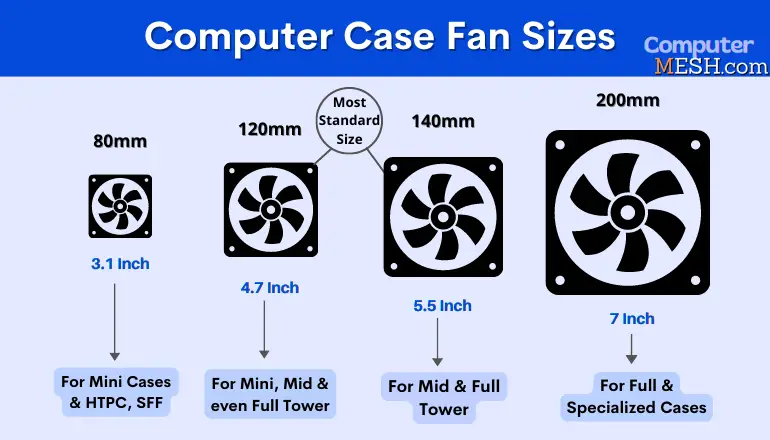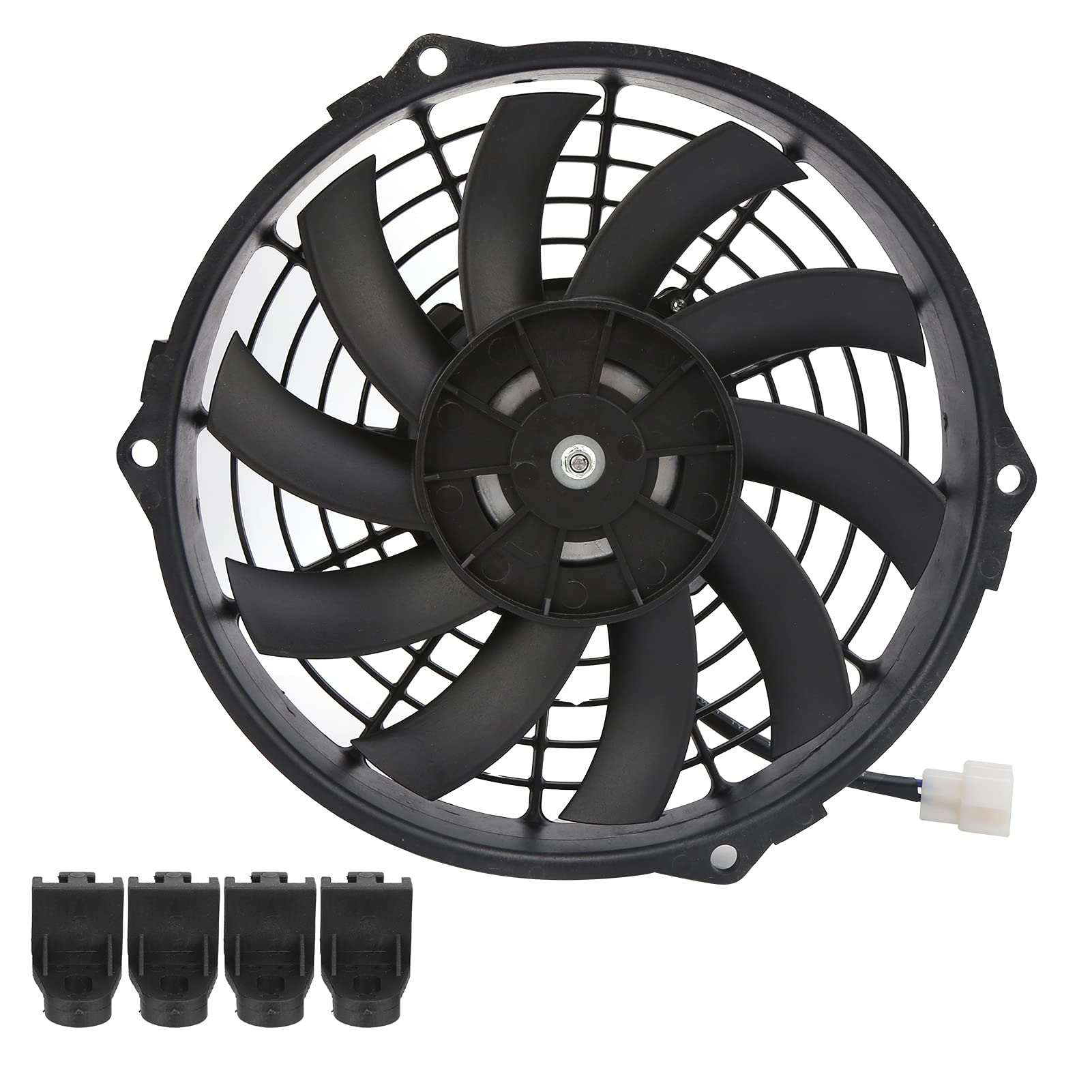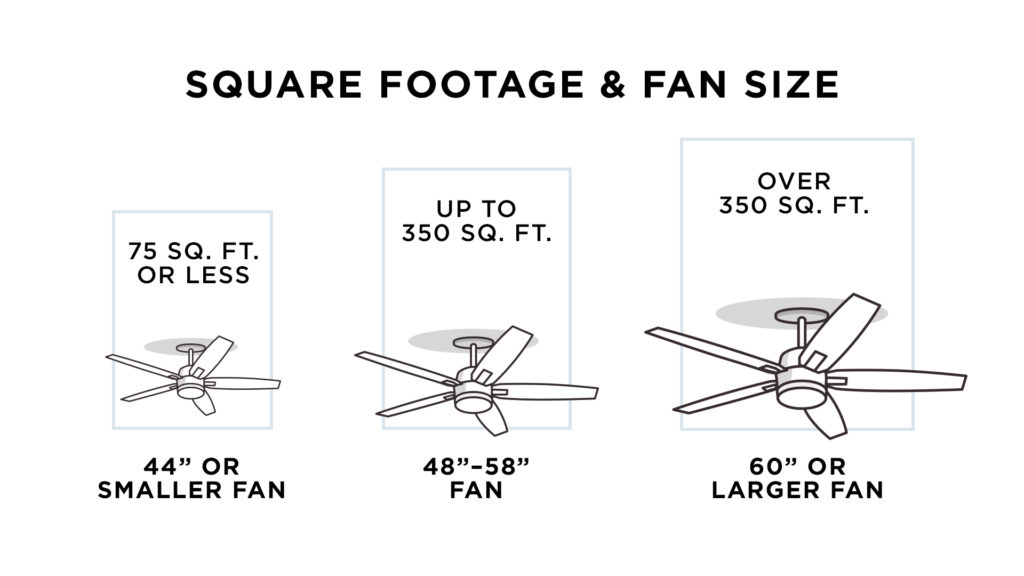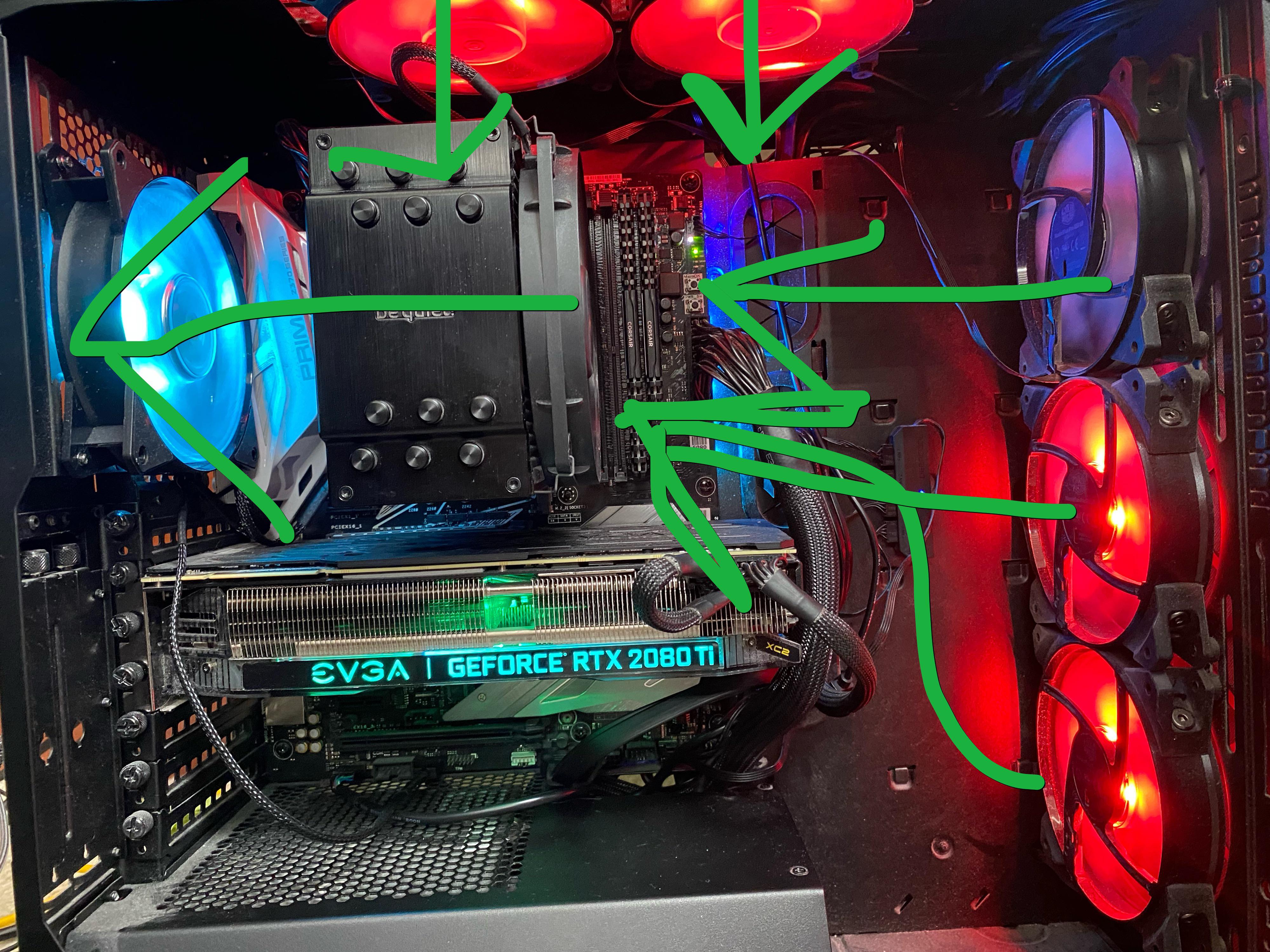Fan Sizes: A Quick Guide

The world of fans is diverse and fascinating, with a wide range of sizes and applications. From small desktop fans to massive industrial ventilators, each fan size serves a specific purpose and plays a crucial role in various industries and everyday life. In this comprehensive guide, we will delve into the different fan sizes, their unique characteristics, and their diverse applications. Get ready to discover the hidden world of fans and unlock their incredible potential.
Understanding Fan Sizes and Their Significance

Fan sizes are not merely arbitrary measurements; they are carefully calculated to ensure optimal performance and efficiency. The size of a fan directly influences its airflow capacity, power consumption, and suitability for specific environments. Understanding fan sizes is essential for professionals in HVAC, electronics, and industrial applications, as well as for consumers seeking the perfect fan for their needs.
Let's explore the various fan sizes and uncover their unique features and applications. Prepare to be amazed by the versatility and importance of these seemingly simple devices.
Micro and Mini Fans: Tiny Titans of Cooling

Starting with the smallest fan sizes, we encounter micro and mini fans. These tiny devices pack a powerful punch and are essential for cooling electronic components and maintaining optimal temperatures in compact spaces.
Micro Fans: Precision Cooling
Micro fans, typically measuring less than 50mm in diameter, are miniature marvels. Despite their size, they offer precise and targeted airflow, making them ideal for cooling specific components in electronics, such as CPUs, GPUs, and hard drives. With their low power consumption and quiet operation, micro fans are the unsung heroes of the tech world.
| Micro Fan Specifications | Key Features |
|---|---|
| Diameter: 20mm - 50mm | Precision airflow, low power consumption |
| Airflow: 0.5 - 3 CFM | Quiet operation, suitable for electronics |
| Applications: CPUs, GPUs, Small Enclosures | High-speed rotation, efficient cooling |

Mini Fans: Compact Cooling Solutions
Mini fans, ranging from 50mm to 120mm in diameter, offer a versatile cooling solution for a wide range of applications. These fans strike a balance between size and performance, making them perfect for cooling laptops, gaming consoles, and other compact devices.
| Mini Fan Specifications | Key Features |
|---|---|
| Diameter: 50mm - 120mm | Versatile airflow, moderate power consumption |
| Airflow: 3 - 15 CFM | Quiet operation, suitable for various devices |
| Applications: Laptops, Consoles, Enclosures | Efficient cooling, customizable options |
Standard Fans: The Workhorses of Airflow
Standard fans, ranging from 120mm to 250mm in diameter, are the workhorses of the fan world. These fans offer a balance between performance and affordability, making them a popular choice for a wide range of applications.
120mm Fans: The Sweet Spot
120mm fans are arguably the most versatile and commonly used fan size. They provide a perfect blend of airflow, noise level, and power consumption, making them ideal for PC cases, server rooms, and other general-purpose cooling applications.
| 120mm Fan Specifications | Key Features |
|---|---|
| Diameter: 120mm | Balanced airflow, low noise, efficient |
| Airflow: 25 - 60 CFM | Wide range of applications, customizable |
| Applications: PC Cases, Server Rooms, General Cooling | Common size, various speed options |
140mm Fans: Enhanced Performance
Stepping up in size, 140mm fans offer increased airflow and performance compared to their 120mm counterparts. These fans are ideal for high-performance PCs, liquid cooling systems, and applications requiring efficient heat dissipation.
| 140mm Fan Specifications | Key Features |
|---|---|
| Diameter: 140mm | High airflow, low noise, efficient |
| Airflow: 35 - 80 CFM | Enhanced performance, suitable for demanding applications |
| Applications: High-End PCs, Liquid Cooling, Industrial Equipment | Common size, offers greater cooling capacity |
Large Fans: Powerhouses of Ventilation
When it comes to handling large volumes of air and providing powerful ventilation, large fans take center stage. These fans, ranging from 250mm to 600mm in diameter, are essential for industrial, commercial, and agricultural applications.
250mm and 300mm Fans: Industrial Cooling
250mm and 300mm fans are commonly used in industrial settings, such as factories, warehouses, and server farms. With their high airflow capacity and robust design, these fans are capable of cooling large areas and maintaining optimal conditions for machinery and equipment.
| 250mm and 300mm Fan Specifications | Key Features |
|---|---|
| Diameter: 250mm - 300mm | High airflow, robust construction |
| Airflow: 100 - 250 CFM | Industrial-grade performance, reliable operation |
| Applications: Factories, Warehouses, Server Farms | Suitable for heavy-duty cooling tasks |
400mm and Above: Massive Ventilation
Fans with diameters of 400mm and larger are true powerhouses, capable of moving enormous volumes of air. These fans are essential for agricultural cooling, industrial ventilation, and applications requiring extreme airflow. They are often used in greenhouse cooling, mining operations, and large-scale ventilation systems.
| 400mm+ Fan Specifications | Key Features |
|---|---|
| Diameter: 400mm and above | Massive airflow, powerful performance |
| Airflow: 500 CFM and up | Suitable for extreme cooling and ventilation |
| Applications: Greenhouse Cooling, Mining, Large Ventilation Systems | Robust design, high efficiency |
Specialty Fans: Customized Cooling Solutions

Beyond the standard fan sizes, there exists a world of specialty fans designed for specific applications and environments. These fans offer unique features and capabilities to meet the demands of niche industries and specialized cooling requirements.
Radial Fans: High-Pressure Applications
Radial fans, also known as centrifugal fans, are designed to generate high-pressure airflow. They are commonly used in HVAC systems, industrial processes, and applications where precise control of airflow direction is required. Radial fans excel at moving air against resistance, making them ideal for ductwork and confined spaces.
| Radial Fan Specifications | Key Features |
|---|---|
| Design: Centrifugal, radial blade | High-pressure airflow, directional control |
| Applications: HVAC, Industrial Processes, Ductwork | Efficient in confined spaces, suitable for high-pressure applications |
Axial Flow Fans: Efficient Air Circulation
Axial flow fans, or propeller fans, are designed for efficient air circulation and are commonly used in cooling towers, evaporative cooling systems, and industrial processes. These fans move air parallel to the axis of rotation, making them ideal for long-distance air movement and applications requiring high-volume airflow.
| Axial Flow Fan Specifications | Key Features |
|---|---|
| Design: Axial, propeller blade | Efficient air circulation, long-distance airflow |
| Applications: Cooling Towers, Evaporative Cooling, Industrial Processes | High-volume airflow, suitable for long-distance cooling |
Impeller Fans: Compact and Powerful
Impeller fans are compact and powerful devices used in a variety of applications, including computer cooling, automotive ventilation, and small-scale industrial processes. These fans offer high airflow in a small package, making them ideal for space-constrained environments.
| Impeller Fan Specifications | Key Features |
|---|---|
| Design: Impeller, compact | High airflow, compact design |
| Applications: Computer Cooling, Automotive Ventilation, Small-Scale Processes | Efficient in confined spaces, powerful performance |
Future Trends and Innovations in Fan Technology
The world of fan technology is constantly evolving, driven by advancements in materials, manufacturing techniques, and energy efficiency. As we look to the future, several key trends and innovations are shaping the next generation of fans.
- Smart Fan Technology: Integrating smart sensors and controls allows fans to adapt to changing conditions, optimizing performance and energy efficiency. Smart fans can adjust speed, direction, and even monitor air quality, making them ideal for smart homes and industrial IoT applications.
- Energy-Efficient Designs: With a focus on sustainability, fan manufacturers are developing energy-efficient designs that reduce power consumption without compromising performance. Advanced blade designs, optimized motor efficiency, and intelligent control systems are all contributing to more eco-friendly fan solutions.
- Materials and Manufacturing: Advances in materials science are leading to the development of lighter, stronger, and more durable fan components. From composite materials to 3D printing, the future of fan manufacturing promises increased efficiency, reduced weight, and enhanced performance.
- Aerodynamic Innovations: Aerodynamic advancements, such as improved blade profiles and airfoil designs, are enhancing fan performance and reducing noise. These innovations result in increased airflow, improved efficiency, and quieter operation, making fans more suitable for a wider range of applications.
Conclusion: The Versatility of Fan Sizes
Fans come in a myriad of sizes, each with its own unique characteristics and applications. From the tiny micro fans that cool electronic components to the massive fans that ventilate industrial facilities, every fan size plays a crucial role in maintaining optimal conditions and ensuring efficient operation.
Understanding fan sizes and their applications is essential for professionals and enthusiasts alike. By selecting the right fan size for a given task, one can achieve optimal cooling, ventilation, and airflow control. Whether it's a micro fan cooling a CPU or a massive fan ventilating a warehouse, the right fan size makes all the difference.
As technology advances and new innovations emerge, the world of fan technology continues to evolve, offering even more efficient, sustainable, and versatile cooling solutions. Stay tuned for the latest advancements and explore the incredible potential of fans in various industries and everyday life.
Frequently Asked Questions
How do I choose the right fan size for my application?
+
Selecting the right fan size depends on several factors, including the airflow requirements, available space, and desired noise level. For general cooling, a 120mm fan is a good starting point. For more demanding applications, consider a larger fan size or multiple smaller fans. Always refer to the manufacturer’s specifications and guidelines to ensure optimal performance.
What are the benefits of using specialty fans, like radial or axial flow fans?
+
Specialty fans offer unique advantages for specific applications. Radial fans excel at generating high-pressure airflow, making them ideal for HVAC systems and industrial processes. Axial flow fans are efficient for long-distance air movement and are commonly used in cooling towers and evaporative cooling systems. Choosing the right specialty fan ensures optimal performance and efficiency for your specific needs.
Are there any energy-efficient options for fans?
+
Absolutely! Many fan manufacturers now offer energy-efficient models with optimized blade designs, advanced motor technology, and intelligent control systems. These fans reduce power consumption without compromising performance, making them an excellent choice for environmentally conscious consumers and businesses.



